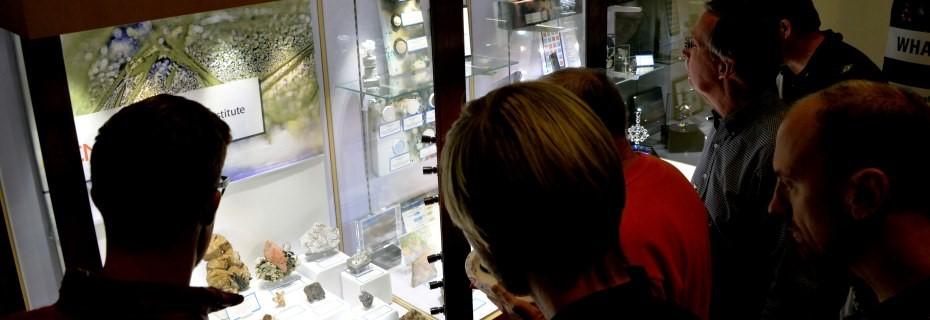The Critical Materials Innovation Hub (CMI) developed a critical materials exhibit at the Colorado School of Mines Museum of Earth Science. This video provides a virtual tour of the exhibit during 2025, provided by CMI Deputy Director Rod Eggert, Colorado School of Mines.
The Critical Materials Institute developed a museum exhibit at the in the Mines Museum of Earth Science at the Colorado School of Mines.
The Critical Materials Museum Exhibit is a prototype exhibit for education professionals interested in building a similar exhibit.
A series of "how to" reports were generated at key stages of the design-build process:
- First report: Critical Materials Museum Display Status and "How-To" Report No. 1, nine-page pdf. The report includes links to exhibit case vendors and these links:
- Denver Art Museum uses rare earth magnets to display art (link no longer available)
- Earth Science Museum built a display for the Tucson Gem and Mineral Show, showcasing minerals and elements used in smartphones. Here’s a video: (1:18)
- Rare Earths on display in the Inner Mongolia Autonomous Region Museum, Hohhot, China
- Second report: CMI museum exhibit report 2: What to consider before and during the Acquisition Process, six-page pdf. The report includes questions to ask for a successful design build, budget and communication, as well as a brief guide for purchasing minerals, chemicals and cases. The report includes these links for minerals:
- minfind.com - The Fine Mineral Search Engine (link no longer available)
- Xpo Press
- Collectors Edge Minerals
- Crystal Classics
- Khyber Minerals
- Third report (final report): CMI museum report 3: final report, a 15-page finale includes progress update and lessons learned in creating the exhibit at Colorado School of Mines
- Appendix A: People who made the exhibit possible, 3-page pdf
- Appendix B: Table of exhibit contents on display, 12-page pdf
- Appendix C: Resources for the critical materials exhibit, 3-page pdf
Exhibit Updates
CMI coordinates updating the Critical Materials Exhibit at the Mines Museum of Earth Science, with a goal to change at least 25 percent of the exhibit. Highlights in developing the exhibit include:
- CMI Year 3
- Fall 2015, exhibit installation. The museum exhibit opened to local visitors in December 2015.
- February 2016, grand opening during the CMI Winter Meeting at Mines
- CMI Year 4
- Summer 2016, solar panels installed to power exhibit at the Mines Museum of Earth Science
- December 2016, Solar Installation Workshop
- Add magnet recycling research display
- Developed a toolkit with input from researchers and teachers, available for checkout at the museum
- CMI Year 5
- Install new solar panel to power the exhibit
- Infographics updated to communicate the story of ore, properties of chemicals, and energy technologies.
- CMI Year 6
- Installed touch-screen interface with videos about rare earths and critical materials
- Installed new interactive exhibit with different types of lighting powered by the solar panel installed earlier
- CMI Year 7
- Install new display about CMI projects that won major awards, including R&D 100 Awards, TechConnect Innovation Awards, and regional or national awards from the Federal Laboratory Consortium (FLC).
- Updated wind turbine exhibit and samples throughout the CMI critical materials exhibit
- Use exhibit samples from Mines at Ames during visit with the U.S. Secretary of Energy
- CMI Year 8 (during 2020-2021, the museum was closed to public due to pandemic)
- CMI Year 9
- Updated interactive display, and extended use of the monitor by using outside of the museum at the Winter Meeting at Mines, during the CMI annual review in Ames and at the first ever Global Clean Energy Action Forum (GCEAF), in Pittsburgh, Pennsylvania, that included representatives from 34 countries.
- Installed new display cases and signage, including a large map showing locations of rare earth element deposits around the world.
- Updated teacher and public tour guides and added a new "CMI Successes" banner highlighting CMI research
- CMI Year 10
- A flow chart explaining the typical Mining Cycle process for a mine operation from
ore body blasting until reclamation, as a part closure mine process at the end of life of the mine. - ‘Solar Panel’ section added a picture showing ‘farming’ between the solar panels.
- In the Research Success section, a subsector labeled as ‘Future of Mining’ was added describing the ‘Sea Bed’ and ‘Space Mining’, as futuristic trend for critical materials/minerals sources.
- “Circular economy for rare earth elements graphic was added to the CMI banner.
- A flow chart explaining the typical Mining Cycle process for a mine operation from
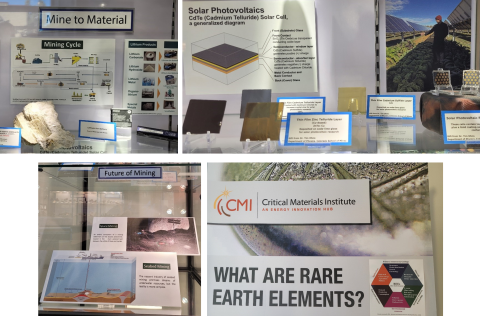
CMI offered a Solar Installation Workshop including more than two dozen people from Red Rocks Community College and Colorado School of Mines. RRCC Instructor Troy Wanek (Solar Energy Environments owner and solar installer), shared details of a solar install on a government building. He led the group through the install process, including a walk-through from the solar panel outside, through the warehouse, to the phosphor and efficient lighting components of the Critical Materials Exhibit. The unique solar panel installation at the Mines Museum of Earth Science began from the donation of a CdTe solar panel (from First Solar) and a CIGS panel (from EPRI; made by Solar Frontier). These two panels (CdTe and CIGS) were installed and now power a portion of the Critical Materials exhibit inside the museum, creating the first working solar photovoltaic module system at Mines.
For further information please contact:
Danielle Ladd dladd@mines.edu
Research Faculty, Education & Workforce Development
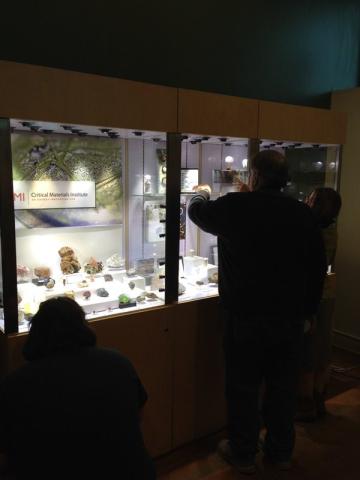
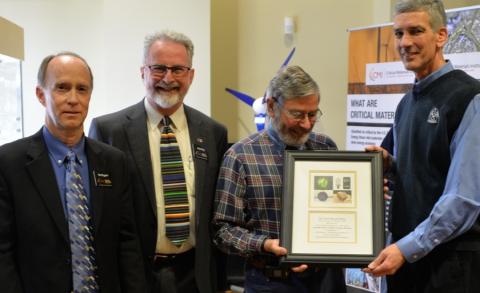
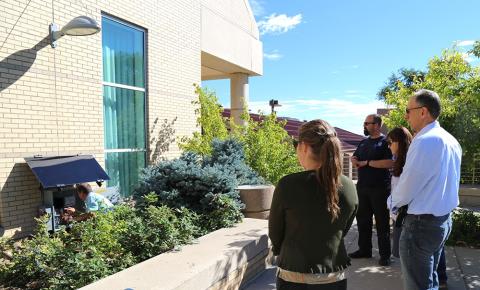

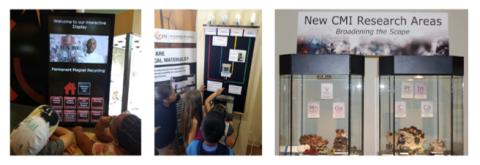
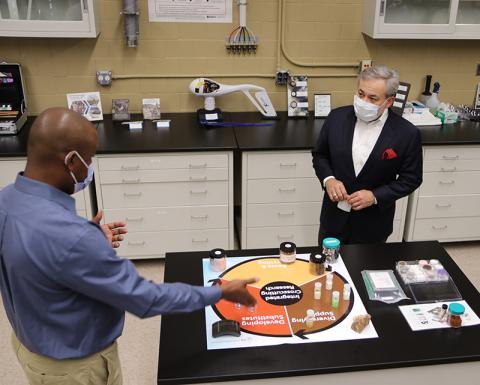
Secretary Dan Brouillette (shown right), who toured the Controlled Atmosphere Materials Processing System (CAMPS). CMI project lead Ikenna Nlebedim (shown left) describes the award-winning acid-free dissolution process that can remove cobalt and rare earth elements from used electronics, without operational hazards or environmental impacts associated with acid-based dissolution processes and while maintaining the quality of other parts for recycling.

